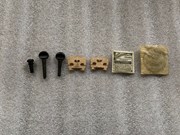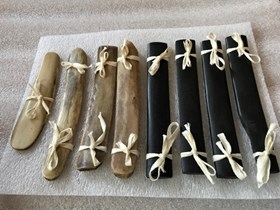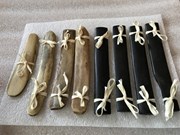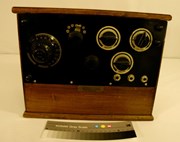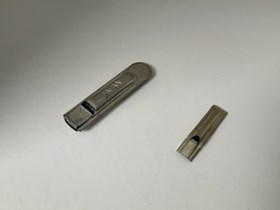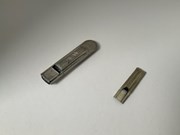Narrow Results By
Accessories Violin Accessories
https://archives.whyte.org/en/permalink/artifact104.34.0007%20a-g
- Date
- 1925 – 1950
- Material
- wood; paper; catgut; shell; metal
- Catalogue Number
- 104.34.0007 a-g
- Description
- A collection of violin accessories: (a) tailpiece button (3.2 x 1.7 diam) - hard black wood peg with round button head and small dot of nacre inlaid at middle, stocky shaft. (b) peg (6.7 x 1.1 x 2.4) hard black wood peg with long tapering shaft and flattened, depressed, finger grip at end, small …
1 image
- Title
- Accessories Violin Accessories
- Date
- 1925 – 1950
- Material
- wood; paper; catgut; shell; metal
- Dimensions
- 3.2 cm
- Description
- A collection of violin accessories: (a) tailpiece button (3.2 x 1.7 diam) - hard black wood peg with round button head and small dot of nacre inlaid at middle, stocky shaft. (b) peg (6.7 x 1.1 x 2.4) hard black wood peg with long tapering shaft and flattened, depressed, finger grip at end, small dot of nacre inlaid at middle of end, tiny hole drilled through shaft nearly halfway up. (c) peg (5.9 x .9 x 2.3) as (b) but slightly smaller, hole through shaft lowe. (d) bridge (4.7 x 3.9 x .5) cut out of unfinished wood with scrolled carving at sides around short legs and at middle, arched top with four shallow notches for strings. Marks: on side, "PANPI (TC monogram trademark)" (e) bridge (4.5 x 3.2 x .5) as (d). Marks: on side, "VUILL?TIME", penciled "10" (f) string package (5.5 x 5.4) white paper envelope holding "Muller's Eternelle First violin string" with accompanying product blurb printed in black, holds coiled catgut string with tiny yellow loop at one end (unused) (g) string package (7.3 x 7.2) cellophane envelope with paper label of same size slipped inside with slits cut to hold string, label printed in black with "The Bernhardt String made of silver steel (trademark)/ violin E", contains two coiled strings, 1 broken of catgut, and the other of very fine wire (e string) wrapped with yellow at one end, (unsure if string is original one of envelope, catgut string definitely not).
- Subject
- Whyte home
- households
- entertainment
- pastime
- Annie White
- music
- sound
- song
- musical equipment
- accessories
- Credit
- Gift of Catharine Robb Whyte, O. C., Banff, 1979
- Catalogue Number
- 104.34.0007 a-g
Images
This material is presented as originally created; it may contain outdated cultural descriptions and
potentially offensive content.
Read more.
Floor; Electric Radio
https://archives.whyte.org/en/permalink/artifact105.04.1008
- Date
- 1925 – 1933
- Material
- wood; glass; metal; fibre; paper
- Catalogue Number
- 105.04.1008
- Description
- Floor model electric radio. Wooden frame with rounded corners in front. Glass dial 9.5 x 27.5 with six radio bands, centered in the dial is a round glass eye. Above the dial are six push buttons. Four round knobs 5.0 dia. below dial for tuning. Below that are two panels of a brown and yellow…
1 image
- Title
- Floor; Electric Radio
- Date
- 1925 – 1933
- Material
- wood; glass; metal; fibre; paper
- Dimensions
- 99.5 x 72.5 cm
- Description
- Floor model electric radio. Wooden frame with rounded corners in front. Glass dial 9.5 x 27.5 with six radio bands, centered in the dial is a round glass eye. Above the dial are six push buttons. Four round knobs 5.0 dia. below dial for tuning. Below that are two panels of a brown and yellow plaid fabric each 52.0 x 13.0.
- Subject
- households
- entertainment
- Credit
- Gift of Richard Ernest Morton Parker, Calgary, 1997
- Catalogue Number
- 105.04.1008
Images
This material is presented as originally created; it may contain outdated cultural descriptions and
potentially offensive content.
Read more.
Musical Bones Sets
https://archives.whyte.org/en/permalink/artifact104.33.0027%20a-h
- Date
- 1920 – 1945
- Material
- bone; wood
- Catalogue Number
- 104.33.0027 a-h
- Description
- Two sets of minstrel's bones, each set consisting of two pairs. (a-d) are actual segments of rib bones which have been rounded at the ends and polished smooth. (e-h) are hard pieces of black wood ebony? , lenticular in cross section, curved to mimic the rib bones, but cut off square at the ends.…
1 image
- Title
- Musical Bones Sets
- Date
- 1920 – 1945
- Material
- bone; wood
- Description
- Two sets of minstrel's bones, each set consisting of two pairs. (a-d) are actual segments of rib bones which have been rounded at the ends and polished smooth. (e-h) are hard pieces of black wood ebony? , lenticular in cross section, curved to mimic the rib bones, but cut off square at the ends. (a) 14.3 x .9 x 3.9 - bone, slightly spatulate shape with rounded ends. (b) 17.2 x 1.0 x 3.0 - bone, long, and thick at one end, rounded ends. (c) 18.3 x 1.0 x 3.0 - bone, long, rounded at ends, with slight twist in bone. (d) 17.0 x .8 x 3.2 - bone, long, squared at ends.( e-h) 17.9 x .8 x 2.6 - black wood, straight sided, cut off square at ends, and curving upward. Note: (h) 6.5 cm long piece broken off one end, .2 cm deep saw cut on side opposite, and uneven, close grooves on concave surface, a saw again?
- Subject
- Whyte home
- households
- entertainment
- minstrel show
- Annie White
- music
- musical equipment
- sound
- song
- Credit
- Gift of Catharine Robb Whyte, O. C., Banff, 1979
- Catalogue Number
- 104.33.0027 a-h
Images
This material is presented as originally created; it may contain outdated cultural descriptions and
potentially offensive content.
Read more.
- Date
- 1920 – 1960
- Material
- metal; wood
- Catalogue Number
- 105.02.1142
- Description
- Three printing plates, one of which is mounted on wood, with images of the Simpson sisters figure skating, posing hand in hand, and sitting at a table.This item was transferred to the Archives by SS in May/June 2014.
- Title
- Offset Plate
- Date
- 1920 – 1960
- Material
- metal; wood
- Dimensions
- 10.0 x 12.0 cm
- Description
- Three printing plates, one of which is mounted on wood, with images of the Simpson sisters figure skating, posing hand in hand, and sitting at a table.This item was transferred to the Archives by SS in May/June 2014.
- Credit
- Gift of Mary Hallock, Fort St. James, 1995
- Catalogue Number
- 105.02.1142
This material is presented as originally created; it may contain outdated cultural descriptions and
potentially offensive content.
Read more.
Peanut Tube Radio
https://archives.whyte.org/en/permalink/artifact105.04.1016%20a-c
- Date
- 1924
- Material
- wood; metal; plastic; glass; fibre
- Catalogue Number
- 105.04.1016 a-c
- Description
- A peanut tube (three-tube) radio enclosed in a varnished brown wooden box/cabinet (a) with a hinged lid. The lid has two small metal screw eyes on each side of the inside (2.0cm from the corner) attaching it to the cabinet which has two metal hooks (2.0cm down from the front corner) screwed into pl…
1 image
- Title
- Peanut Tube Radio
- Date
- 1924
- Material
- wood; metal; plastic; glass; fibre
- Dimensions
- 26 x 18 x 32.5 cm
- Description
- A peanut tube (three-tube) radio enclosed in a varnished brown wooden box/cabinet (a) with a hinged lid. The lid has two small metal screw eyes on each side of the inside (2.0cm from the corner) attaching it to the cabinet which has two metal hooks (2.0cm down from the front corner) screwed into place on both sides. These are used to close the lid securely to the main cabinet. A paper diagram of the circuitry board is tacked to the obverse side of the lid with six metal thumbtacks. The diagram outlines the blueprint of the radio (b), which is separate from the cabinet; the radio slides out of the front from two grooves cut into the sides of the cabinet. The cabinet has two holes bored into the back to attach it to a wall. The front of the radio has a plastic panel secured in place to the base, which is a flat piece of wood, by the dials etc. and four screws on the bottom. Extreme left in the top and bottom corner are two small black plastic knobs; the top knob is the antennae, the bottom is the ground knob. In between these to the middle left is a large plastic knob, black with degrees marked in white, adjustable control (0 increasing by 10’s to a 100 degrees) for station tuning; the small knob in centre (starting at 0 increasing by 5 degrees to 2, then 3, both left and right) is for fine tuning. Next, to the top right is an adjustable black knob with a bent metal contact piece attached; it moves left and right moving to make contact with five metal posts used for switching to different radio bands; two metal posts, one at either end, are used to keep the metal contact piece within the five contact points radius. Below this is a plain black plastic adjustable knob used for sensitivity control for the strength of radio station waves. This goes in and out, further and closer, (it is attached to wires covered with a textile). To the right of these are three black plastic knobs adjustable rheostats (that control the filaments of the three tubes inside (R215-A Vacuum tube); this is the volume control. Three nuts (jack has a thread on it to keep in place) are for jacks for headphone output. Jack 3, closest to the edge of the radio, also controls the switch to the speaker (if you want to have a speaker hooked up to loudspeaker). There are two wires attached different colours; they have a sleeve on the corners so it doesn’t short-circuit.The headphones (c) are hard plastic earpieces (6 cm. in diametre); one has a metal back with “FROST (F)ONES NO. 161 1000” , and three screws underneath the lettering; the other is black hard Bakelite plastic with “National” written in script ,“ELECTRIC” in the tail of the L, underneath that “OHMS 100C SINGLE”, two screws and nuts attaching two-fibre covered wires on either side that connect to the plastic and metal jack plug, “MNFD. BY THE NATIONAL ELECTRIC HEATING COMPANY LIMITED TORONTO CANADA”. Each earpiece has a metal piece attached by rivets to each side allowing it to move. The two-band fibre-covered headpiece is connected to the metal piece by two metal wires. The two fibre-cover wires extending from the earphones are joined and covered with a black cord wound around until it forms a loop which is knotted to close. Two plugs that fit into the jack attachment BARKEKLEW SERIESPAT. PENDING NUMBERS 1,2,3,4, negative on the left side and positive on the right making 8 hole plugs, 2 screws in the place attaching to the metal jack that plugs into the radio.Blueprint hand drawn for back.
- Subject
- households
- furniture
- entertainment
- Credit
- Gift of Lorne Cooley, Banff, 2008
- Catalogue Number
- 105.04.1016 a-c
Images
This material is presented as originally created; it may contain outdated cultural descriptions and
potentially offensive content.
Read more.
- Date
- 1920 – 1950
- Material
- metal
- Catalogue Number
- 108.05.0086 a,b
- Description
- Two small tin whistles, each of which only plays one note. (a) larger, flat tube of tin with flanged seam down both sides and around rounded bottom. Mouthpiece flattens out and has rectangular hole cut through the top and a matching hole on the bottom. Metal vibrating reed held in the middle of th…
1 image
- Title
- Tin Whistle
- Date
- 1920 – 1950
- Material
- metal
- Dimensions
- 0.7 x 7.0 cm
- Description
- Two small tin whistles, each of which only plays one note. (a) larger, flat tube of tin with flanged seam down both sides and around rounded bottom. Mouthpiece flattens out and has rectangular hole cut through the top and a matching hole on the bottom. Metal vibrating reed held in the middle of the mouthpiece by the seam on each side. Illegible letters are stamped on one side and “JAPAN” is stamped on the other. (b) smaller (4.4 cm length) brass coloured on top, tin on bottom. Small round tube with flanges on either side which are crimped together to form seam. Flange is square at bottom. Mouthpiece flattens and is bent downward slightly, semicircular notch at point where mouthpiece flattens on top.
- Credit
- Gift of Catharine Robb Whyte, O. C., Banff, 1979
- Catalogue Number
- 108.05.0086 a,b
Images
This material is presented as originally created; it may contain outdated cultural descriptions and
potentially offensive content.
Read more.


